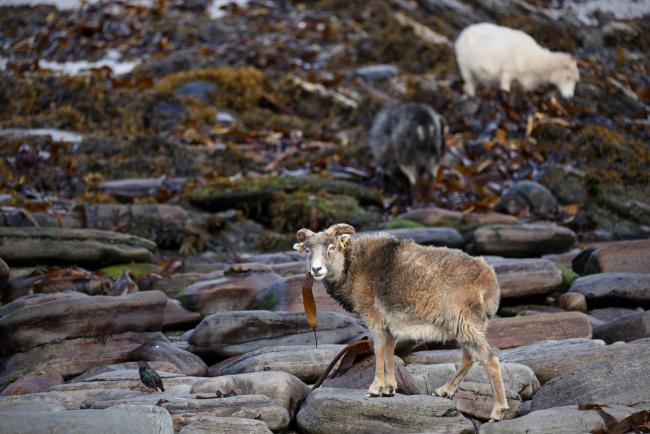The seaweed-eating sheep that may help us to climate-friendly meat
By Vicky Allan
Senior features writer
HERALD SCOTLAND
11th January

The two-metre-high and 12-mile-long wall circling North Ronaldsay is probably the largest such continuous dry-stone dyke in the world, its purpose being to keep a unique breed of sheep out. The construction is a barrier, nearly two centuries old, that prevents the North Ronaldsay flock from reaching the grass that feeds the cattle, and keeps them to the foreshore, where they forage on a diet of seaweed.
The mutton from these small sheep is considered a gastronomic delicacy, served to the Queen at her Diamond Jubilee, and described as “gamey” in flavour. But also, more recently, this rare breed has drawn global attention because it is believed that they might provide clues for how to rear low methane-producing meat.
There has been much hype in recent years about the possibility that the introduction of seaweed to recent feeds might help reduce emissions of the methane, a greenhouse gas which is 25 times more potent than carbon dioxide in terms of trapping heat in the atmosphere. One study at the University of California found sprinkling 85g of seaweed a day into a cow's feed cut methane production by more than 80 percent. This asparagopsis seaweed produces a compound which inhibits the enzyme in the gut which enables formation of methane.
READ MORE: A cry for kelp. Why Scotland's green future could be blue
Methane is burped, and farted, out into the atmosphere by cattle and sheep. The average cow produces 160 to 320 litres of methane every day, the average sheep around 30 litres. We do not yet know the average daily emissions for the North Ronaldsay sheep.
The James Hutton Institute, however, has been researching what these pedigree sheep tell us about a seaweed diet for well over a decade, and has collaborated with Davidsons Animal Feeds, to investigate whether seaweed supplements might work to reduce methane emissions in other sheep and cattle.
Meanwhile, rearing sheep on North Ronaldsay, remains a practice unlike sheep farming anywhere else. A key figure on the island is the sheep dyke warden, whose job it is to maintain the wall. This is crucial, because any break in the wall, could lead to sheep getting through, not only eating grass reserved for cattle, but also impacting on their own health – since the sheep are now highly adapted to their seaweed diet. Long term exposure to the grass is bad for them, as their digestive systems have changed over time and they are now intolerant to the high copper it contains. What fascinates many scientists is the way their digestive systems have adapted, and in particular the way they are able to digest the distinct sugars present in brown seaweeds.
The lives of North Ronaldsay sheep are unlike those of any others. Instead of grazing in the day, and ruminating at night, they forage according to the tides, and, interestingly, it’s in the winter, when gales pile the seaweed high on the shore, when sheep eat best. Distinct in so many ways, the flock show show we may find answers for the future in old and very local practices; why, in this frequently monocultural world, they are so worth preserving.
No comments:
Post a Comment